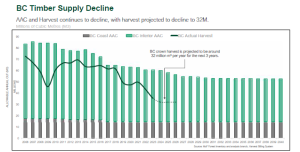
LINDA COADY
This article was published in the Spring 2024 issue of the Truck Logger BC Magazine
By Linda Coady
BRITISH COLUMBIA – A dramatic drop in harvest levels is putting the benefits created by BC’s forest sector and its future at risk. The 2024 BC Council of Forest Industries (COFI) Convention put some solutions on the table.
A lot at stake
On April 10-12, over 700 business, government, First Nations, and community BC Assembly of First Nations (BCAFN) Regional Chief Terry Teegee called out the importance of the successful implementation of BC’s Declaration on the Rights of Indigenous Peoples Act (DRIPA). The regional chief challenged the BC forest sector to move beyond consultation and sent a strong signal about the role that First Nations investors can play in providing a more stable foundation for forest management and manufacturing in BC. He also commented on the need for new thinking on “what we need to do when we don’t agree.”
COFI’s Chief Economist Kurt Niquidet presented results from the updated COFI Economic Impact Study (available at cofi.org) that measured the economic impact of forestry and logging, wood product manufacturing, and pulp and paper manufacturing across the province. The study found that the BC forest sector continues to be a vital part of the provincial economy, responsible for billions in wages and government revenues, sustaining about 49,000 direct forestry jobs, and contributing $17.4 billion in GDP in 2022.
“BC’s forest industry is one of the main drivers of British Columbia’s eco-nomic base, generating outsized benefits to wages, living standards and government revenue by providing employment, manufacturing activity, and exports,” confirmed Niquidet. And he warned that, “Many of these benefits are at risk right now if we can’t find a way to create more predictable access to a supply of economic fibre.”
Niquidet made the case for action to ad-dress the major contraction in fibre supply now occurring in BC (see graph below).

Since 2018, the annual harvest in BC has dropped by almost half from 60 mil-lion cubic metres to 32 million projected for 2024. Equally important, the graph shows a widening gap between the allowable annual cut (AAC) and the actual amount harvested each year. BC’s chief forester establishes the AAC as the sustainable harvest level for the province’s public forests. In 2023, the actual harvest was 42 per cent below the AAC, a drop that correlates with the projected loss of 10,000 forestry-related jobs (direct, indirect, and induced) that year. This down-ward trajectory has continued into 2024 with West Fraser, Western Forest Products, Canfor and others announcing addition-al closures and curtailments.
Daryl Swetlishoff, head of equity research for Raymond James Ltd., predicted that until current uncertainty surrounding access to economic and sustainable fibre in BC is addressed, many investors will opt to stay on the sidelines. This challenge is reflected in Canfor’s recent decision to suspend a $200M investment to rebuild a sawmill in Houston, BC.
The first hour of the 2024 COFI Convention identified the priority of unlocking fibre supply. The next day and a half focused on how to do that.
Accelerating Solutions
A series of speakers and panels tackled the factors that have contributed to the decreasing harvest and reduced the sector’s economic competitiveness. They identified opportunities to regain competitive advantage while strengthening environmental and social performance. The forest sector’s ability to contribute to Indigenous recon-ciliation, reducing climate risks, and sustaining the economic well-being of local communities and the province was seen as fundamental to the sector’s future.
Solutions on how to get to that future were offered. While not everyone agreed on them all, discussions on what it is going to take to solve the problems confronting the sector were frank and constructive.
There was unanimous agreement on one thing: there is no single, simple way forward from here. Meaningful change requires decision makers and stakeholders in the BC forest sector including the Province, First Nations, industry, local communities, labour, and contractors to come together around a multi-faceted portfolio of solutions that can be applied in both the short and long term.
The following are five ideas put for-ward for inclusion in a strategy for predictable fibre supply in BC:
- Remedy current permit development processes to ensure that an environmentally sustainable and economically viable harvest can be consistently achieved.
- Address extended delays and enhanced risks in the development of harvesting permits.
- Ensure the pace of legislative and regulatory change allows for transition, and implementation frameworks are understood and in place before new policies are applied.
- Set a goal of creating a two-year standing timber inventory.
- Evolve BC Timber Sales (BCTS), starting with a review of their current business model and its role in responding to changing conditions and priorities in the BC forest sector.
- Secure agreements with First Nations that advance progress on critical issues.
- Embrace new approaches to consultation, forest tenure, revenue sharing, and First Nations land use planning.
- Expand the role of First Nations as investors in the BC forest sector.
- Pursue new models for avoiding disputes and resolving them.
- Expedite new regional tables for forest landscape planning.
- Create early benefits for all parties at the table by taking a phased approach to initial and interim outcomes before total plan completion (which could take several years).
- Prioritize and get broad-based agreement on a set of short-term results with a focused track and capacity to achieve them.
- Pilot new tools for three-zone forest management and conservation financing that can help implement new goals for old-growth, biodiversity and cultural protection.
- Support more innovative forest management.
- Establish new targets and financing strategies to expand the role that collaborations on research and forest management (silviculture, thinning, cultural and prescribed burning, and salvage of damaged timber) can play in wildfire resilience, community and biodiversity protection, and fibre utilization.
- Develop a multi-year roadmap and economic strategy for the BC forest sector.
- Build alignment on a long-term sectoral strategy and remove hurdles to managing for longterm objectives.
- Plan ahead for transition and workforce development to minimize the impact of industry capacity rationalization and job loss in the sector.
- Rethink supply chains to boost primary and value-added and manufactured wood products as well as the production of bioenergy and other new biomaterials.
- Put forward a more compelling narrative for the BC forest sector that can attract new investment and enable the sector to compete in growing markets for forest products locally and globally, while providing leadership in carbon management, sustainability, and Indigenous-led forest.
Time to Act
BC Forests Minister Bruce Ralston and BC Minister of State for Sustainable Forestry Innovation Andrew Mercier were in the room throughout the convention. They highlighted Minister Mercier’s mandate to engage with companies, communities, and First Nations across BC to get fibre moving again at the local level. The ministers discussed other actions taken by the Province, including additional funding for projects under the Forest Enhancement Society of BC and the BC Manufacturing Jobs Fund. New measures for speeding up permits for salvage and thinning are being introduced. Other new programs and incentives are aimed at accelerating value-added manufacturing and the use of engineered wood products like mass timber and systems for modular and offsite construction in affordable and low-carbon housing and buildings.
Wrapping up the program, BC Premier David Eby echoed the call for greater collaboration on solutions and acknowledged that this will require a stable policy environment moving forward.
The last couple of years in the BC forest sector have been tumultuous. One of the key takeaways from the convention was that consensus is growing on what can be done to get the sector back on track. An-other was that the time to act on that consensus is now.


